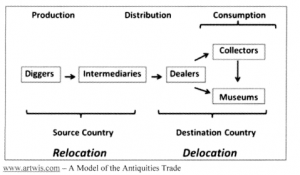The Topic: Looting and the illegal sale of antiquities from Syria and Iraq to finance militant operations.
What’s New: The Canada Border Services Agency (CBSA) warned its officers that looted antiquities from Syria and Iraq are being trafficked worldwide. The officers were told that they have the authority to detain suspected cultural properties from Syria and Iraq.
Why It’s Important: According to an intelligence brief from the spring of 2015, militant organizations like the Islamic State of Syria and the Levant (ISIL), the Free Syrian Army and al Qaeda are smuggling Syrian and Iraqi antiquities around the world—including to places in Europe and North America—and are selling them for profit.
The intelligence brief was obtained from the CBSA as a previously requested document under the federal Access to Information Act. It highlights the fact that profits from illegal antiquity sales could fund weapons and ammunitions for militant organizations.
While the smuggling and sale of antiquities has been happening for decades, the brief says that “the scale of the reported looting of antiquities from museums, libraries, archives and archaeological sites in Iraq and Syria has surpassed illicit operations in previous years.”

According to the document, smugglers often move the artifacts into Europe using routes from either Turkey, Lebanon, Israel or Gulf states. The artifacts typically have false accreditation papers stating they are from the Holy Land rather than Syria or Iraq.
When it comes to Canada, the brief sites the Cultural Property Export and Import Act, which prohibits illegally exported Syrian and Iraqi artifacts from entering the country.
The brief contains two links to lists of items at risk from Syria and Iraq. The lists come from the International Council of Museums (ICOM). They are detailed with photographs and descriptions of items that could be stolen and sold illegally, such as small sculptures, coins, jewellery and stone tablets with ancient writing on them.
What the government says: When asked if any artifacts have been seized recently in Canada, CBSA spokesperson, Nicholas Dorion, said in an e-mail response that the CBSA detains artifacts on behalf of Canadian Heritage. He said any information on artifacts that have been seized would be from them.
Canadian Heritage has yet to respond to questions about the matter.
“CBSA officers are skilled in examination techniques,” said Dorion. “And [they] use proven indicators such as advanced information, innovative technology, and training to prevent, intercept and apprehend individuals who attempt to smuggle cultural properties into Canada,”
What Others Say: John Osborne, a professor of art history at Carleton University says that it is normal for the CBSA to be alerting its officers about these stolen antiquities. Osborne has been asked by the CBSA to authenticate seized antiquities before.
“Anytime there’s a breakdown of civil order, you see an increase in looting activity,” says Osborne.
He says that individuals that are buying these antiquities are typically private collectors since Museums are very strict about accepting gifts or buying pieces if their origins cannot be explicitly traced.
Dr. Clemens Reichel, a curator at the Royal Ontario Museum (ROM) and specialist in Near Eastern archaeology says that currently, it is hard to tell what is missing from Syria since there aren’t any individuals on the ground there who can keep track of things.
“It’s a dark cess pool,” says Reichel about Syria and the black market. “You don’t know what’s being bought all over the world.”
However, Reichel does not think Canada has a major market for smugglers since many of them are going to places like Europe, Jordan and Israel instead.
What’s next: Reichel says that there have been discussions at the ROM and at a national level in regards to what would happen to any artifacts that are seized here.
“Customs would hold on to the piece,” says Reichel. “But if it becomes a storage issue, like for items that need temperature control, the option would be for national museums to become temporary custodians of the piece.”
Reichel says that ideally, the items will be sent back to their country of origin once it is safe for them to return.
Supplementary Documents:
Click here for documentation of my completed Access to Information and Freedom of Information requests.
Click here for the documentation used in this story.
